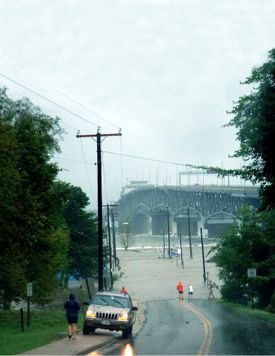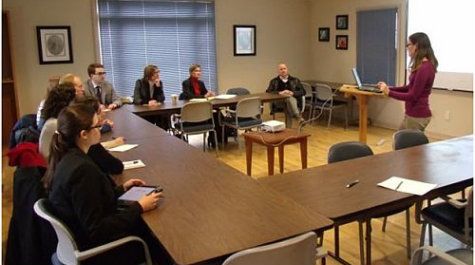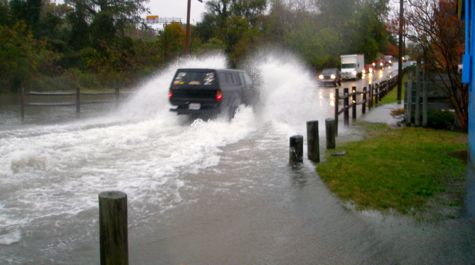Virginia Coastal Policy Clinic tackles legal issues of rising waters
And with good reason. The Law School’s Virginia Coastal Policy Clinic (VCPC), a partnership between the Law School and VIMS' Center for Coastal Resources Management (CCRM) at the Virginia Institute of Marine Science, allows students to integrate the latest science with legal and policy analysis to solve coastal resource management issues.
“This is a great experience for our students, getting them briefed on the science and the know-how of VIMS,” says Shana Jones, director of the VCPC. “They receive exposure to real-world problems—from property rights to federalism to insurance—and gain valuable lawyering skills by learning how to gather facts and work with experts in other disciplines.”
 Among the clinic’s first students was Mary-Carson Saunders ’13. A Hampton Roads native, Saunders was instantly drawn to the clinic’s mission, enjoying a crash course in practical learning about environmental topics from VIMS faculty and other coastal science experts.
Among the clinic’s first students was Mary-Carson Saunders ’13. A Hampton Roads native, Saunders was instantly drawn to the clinic’s mission, enjoying a crash course in practical learning about environmental topics from VIMS faculty and other coastal science experts.“William & Mary is positioned well geographically to tackle coastal issues,” she says, “and our partnership with CCRM provides us with the most current science to shape our legal and policy analysis and recommendations.”
During the clinic’s first semester, students were asked to develop jurisdictional case studies of the flood-prone coastal town of Poquoson and the city of Norfolk.
“We identified various legal issues that may result from the localities’ attempts to prepare and plan for sea-level rise and recurrent flooding,” Saunders says. “Each of us focused on a unique issue, such as takings liability, the Dillon Rule, environmental justice, and tort liability for both localities.”
Jones has 8 students per semester working in the clinic. She doesn’t involve them in litigation, but she wants them to master the facts underlying environmental policy problems and then learn how the law and policy inform such facts.
When Jones envisioned the clinic, she felt that the Law School would be the perfect host. Not only was leading property rights and coastal law expert Lynda Butler on the faculty, as well as local government expert Ron Rosenberg, but the CCRM was seeking consistent legal information in its official role as technical advisor to the state of Virginia and local governments on matters related to the coastal environment.
“Over the years, we identified a critical need for integrated legal analyses to fully inform our clients on many of the more complicated issues,” says Professor Carlton H. Hershner, Jr., director of the CCRM. “The Law and Policy Clinic is an outstanding solution, providing close collaboration among faculty as well as a real-world training ground for both VIMS and law students.”
 Collaboration was the order of the day in September when the VCPC and the CCRM hosted a day-long conference on “Adaptive Planning for Flooding and Coastal Change in Virginia: Legal and Policy Issues for Government.” Public officials, including Virginia Secretary of Natural Resources Doug Domenech, Delegate Chris Stolle, Senator John Watkins and the mayors of Norfolk, Hampton, and Virginia Beach; and attorneys, scientists, and environmentalists, such as Executive Director of the Virginia Environmental Endowment Joseph Maroon, and concerned citizens, gathered to discuss issues created by recurrent flooding and coastal change.
Collaboration was the order of the day in September when the VCPC and the CCRM hosted a day-long conference on “Adaptive Planning for Flooding and Coastal Change in Virginia: Legal and Policy Issues for Government.” Public officials, including Virginia Secretary of Natural Resources Doug Domenech, Delegate Chris Stolle, Senator John Watkins and the mayors of Norfolk, Hampton, and Virginia Beach; and attorneys, scientists, and environmentalists, such as Executive Director of the Virginia Environmental Endowment Joseph Maroon, and concerned citizens, gathered to discuss issues created by recurrent flooding and coastal change.With the clinic off to a fast start, Jones’s long-term thoughts envision a broader center that includes expertise beyond VIMS and the Law School.
“We’d love to pull in the College’s Public Policy Program, economists, and GIS people, since mapping is so important in identifying coastal problems,” Jones says. “We’re very interested in identifying areas where socially vulnerable populations such as the elderly, minority populations, or the disabled are at risk from flood waters and increasingly powerful storms.”
For her part, Mary-Carson Saunders may have graduated last May, but she knows a good thing when she sees it. She remains a vital part of the clinic as its first post-graduate fellow.
“I look forward to the great work that the clinic will produce and the impact it will have in our region and the state,” she says. “I want to work with others to ensure that the same coastal resources that I grew up enjoying are available and healthy for generations to come.”
Save the Date! On January 31-February 1, the Law School will host a conference on "The Role of Law and Government in Protecting Communities from Extreme Weather and Coastal Flood Risks: Local, Regional, and International Perspectives." The event is presented by the William & Mary Environmental Law and Policy Review, the Virginia Coastal Policy Clinic, the World Resources Institute, the Virginia Planning Association, and Student Action Environmental Law Society. Pre-registration is required due to limited seating. Admission is free and the public is welcome to attend. Please visit the conference website to register and to view the schedule.



